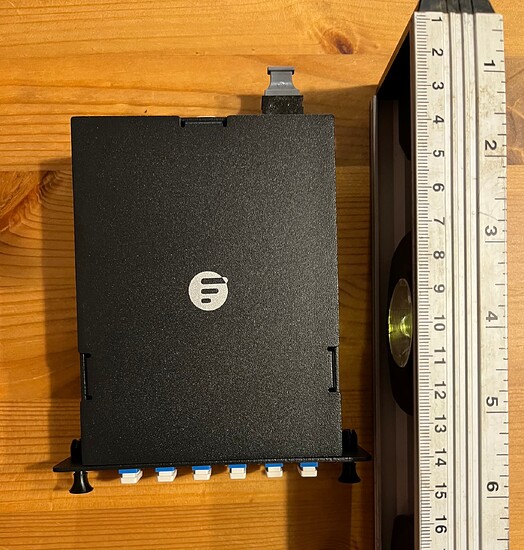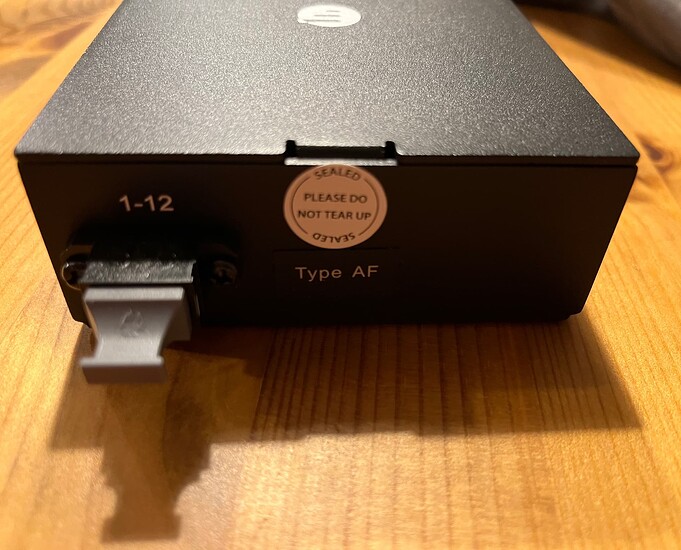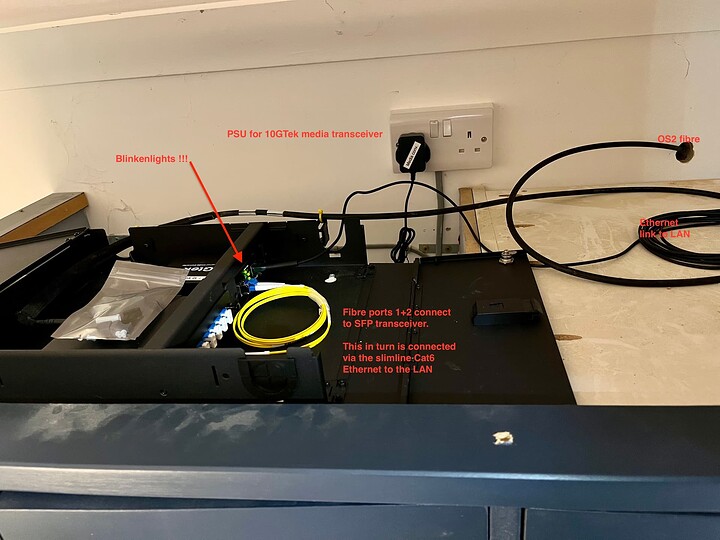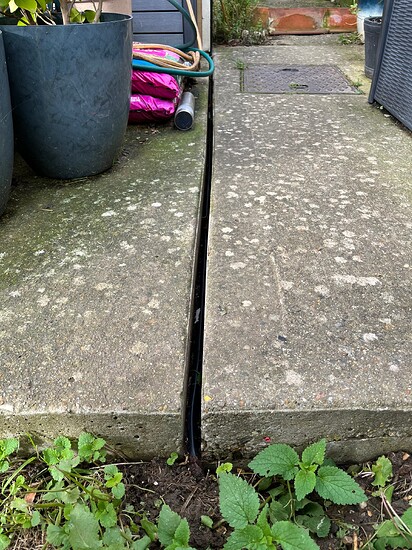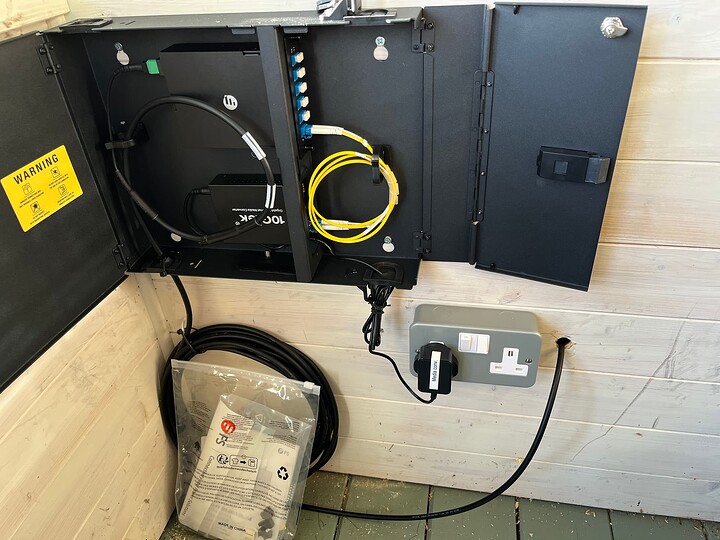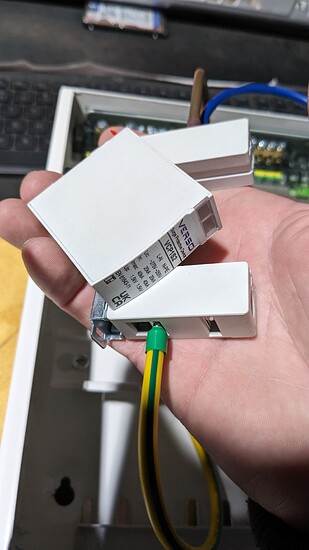Here is a write-up of a project I mentioned while watching @ChrisA’s amazing work on his new office building.
This one has garden aspects but is far simpler. This portion is intended to get basic services to the end of the garden, after which I can plan on adding weather sensors, relocate my old NAS (now an adhoc backup device) and similar fun stuff.
I hope this isn’t too wordy and that the thought process may be of interest.
Objectives
Provide 1) UK mains power and 2) internet connectivity to my wife’s Ladyshed (“Vera”).
Requirements
Considering only the networking side I had the following requirements:
- The network cable should be as future-proof as possible given our use case
- If possible, 10 gigabit speeds should at least be possible in the future
- The chosen solution should be financially agreeable to the House Comptroller aka my darling wife

- The network cable should not act as a lightning attractor
- The network cable must be weather proof since we may not be burying it and we cannot guarantee that any conduit would remain dry
- The network run must also include some form of metal jacketing for rodent protection (and for errant garden tools!)
- The “Vera segment” should be placed on a separate router port for isolation
- The chosen technology should support Ethernet for connectivity since I’m most familiar with this
Much Mulling
As I mulled these over (did I mention I first started jotting down notes a year prior?!) it became clear that it was going to be fibre at which point the question really became “Do I continue with some form of Multimode or go Singlemode?” .
Here are my final jottings taken directly from my notes as I meandered towards a solution. Yes, it takes me ages to buy anything expensive or complex.
* LC connectors (LC-UPC) * If Multi-Mode we need 50/125 * ideally OM4 fibre for future proofing as OM3 is only slightly cheaper (if possible) ** OS2 would be even more future-proof but the SFP+ modules run hotter.... * Duplex fibres (2x LC connectors each end) * For safety at least “Low Smoke Zero Halogen” (LSZH), better is “Optical Fiber Nonconductive Plenum” (OFNP) to guard the indoor portions With all that said: it is probably easiest to go for an MTP connector both ends and break that out as needed.
What was interesting for me is that singlemode SFP+ modules and DACs do not necessarily run hotter. I did not realise this for some time but my Observium install shows both optical transmit power and electrical power usage. When compared to the module spec sheet values they are low, likely because the house-internal fibre runs are relatively short. (I have fs.com SFP+ transceivers with Broadcom and Cisco EEPROM IDs).
That bit was an “aha” moment for me. Obviously I’m not running telecoms-style lengths of fibre so there’s no need for the laser to run at or near maximum, ergo there will be less power draw.
As an aside, a year ago I got a 1.5m (5") 10GbE DAC for testing . I was getting a couple of SFP+ cards from fleabay and was doing a fair amount of plug/test/unplug/etc. I was pleasantly surprised by how cool those ran.
Things start to take form
In the light of my future use case (where it would be unlikely that anything would be running at max capacity for extended periods of time) I felt that singlemode equipment would offer excellent future-proofing while remaining within financial and power budgets.
Similarly, since the MTP technology technology wasn’t that expensive an investment given the long-term nature of the install, I had a brainwave and decided on:
I chose
- 40 metre (circa 120’) which turned out to be far too much but oh well…
- 12 fibres (6 pairs)
- MTP-termination at both ends
- Pulling eyes at both ends (about 50cm of strong mesh sheath ending in a plastic pulling loop)
The fibre ends would be terminated into MTP cassettes ; TWO types are required (A and AF) thus:
and
Considering the fibre spaghetti one sometimes sees these seemed to be very neat. Here’s a photo of one with a spirit level for scale:
It’s possible to get A-types and AF-types confused since the only indicator is at the rear:
The cassettes snap easily into wall mount enclosures. I ordered several enclosure types, one 19" rack-mount, one single-use for my office (that type lacks the side door protecting the ST patches) and two more which offer side-door protection to patch leads.
Patch leads were:
I had the electrician install a new double-gang socket above a cupboard where it would be convenient to run the fibre out of the house. This gave me a completely unused space to locate enclosure, cables, fibre, PSU’s etc.
Here is one double-gang enclosure affixed horizontally to the top of said cupboard.
I hope it is sensibly annotated, the logical flow diagram is:
LAN <---ethernet--> Gbe_Transceiver <--OS2_patch_lead--> MTP cassette <--->OS2_to_Vera
The exit hole to the outside has yet to be plugged in this shot.
Regarding the transceivers, since I did not yet require 10GbE connectivity I found that I could procure GbE-only ones for one tenth the price. Again, given the use case and financials, I found this combo to be a good deal considering it included the SFP module (Amazon UK link, circa £39 / U$50)
I thought they look kind of cute - little handheld things ![]()
One thing to be aware of with those types is that link state is NOT propagated. Fine for a simple run like this, not so good if complex services requiring hardware fail notification are running (BGP).
For comparison, a suitable fs.com 10GbE unit might be the following but at £190.80 (circa U$250) I could even afford to buy spare 1 GbE units until such time as I need the bandwidth:
- [https://www.fs.com/uk/products/101478.html Unmanaged 1x 100M/1G/2.5G/5G/10GBase-T to 1x 10GBase-X SFP+ Slot 10Gigabit Ethernet Media Converter, British Plug Standard]
Running the fibre was relatively easy. The pull loops are thin but strong enough and the MTP connector remains sheathed and protected throughout the run.
The one awkward area in my case was where the cable exited the house proper and I need to cross to the fence or garden.
Conveniently I had just cleared out rotten spacer boards between two concrete pads and it was possible to run it down that gap:
Inside Vera, a double-gand enclosure is mounted midway between window and floor height. Long story short: my wife can shove her favorite comfy chair up against the corner and won’t accidentally dislodge power sockets or enclosure:
As you can see the double-gang enclosure provides protection and space for the fibre cartridge, transceiver and OS2 patch lead. Either side or both can be folded open for easy access and the locks should suffice to keep out curious fingers!
The ethernet patch cord has been removed after successful testing but the plan is to use a Netgear N600 AP running OpenWRT to provide Wifi.
For now, this is a separate LAN, running off a different firewall interface but I do wonder whether I’m being too paranoid. I mean, who am I protecting against - certainly not nation states or multi-national corps!
And yes, given recent gales here, the outside hole HAS been plugged.
An internal run remains as does mounting the 19" rack enclosure. Which involves ethernet re-wiring … which needs doing but then really the rack could do with a re-jig and … we’ll see!
(Polite !) comments and critique always welcome ![]()

